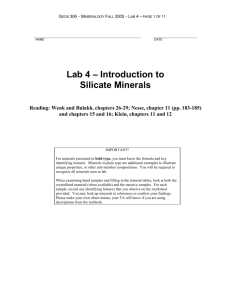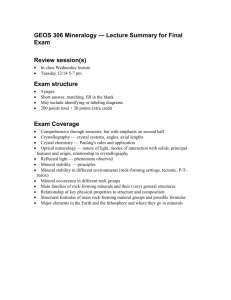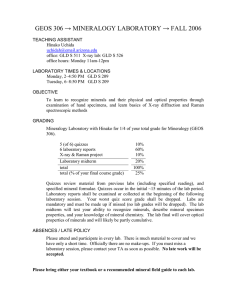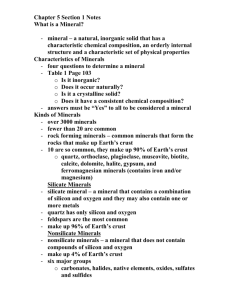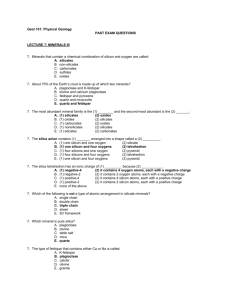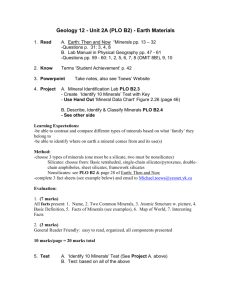– Introduction to Lab 4 Silicate Minerals
advertisement
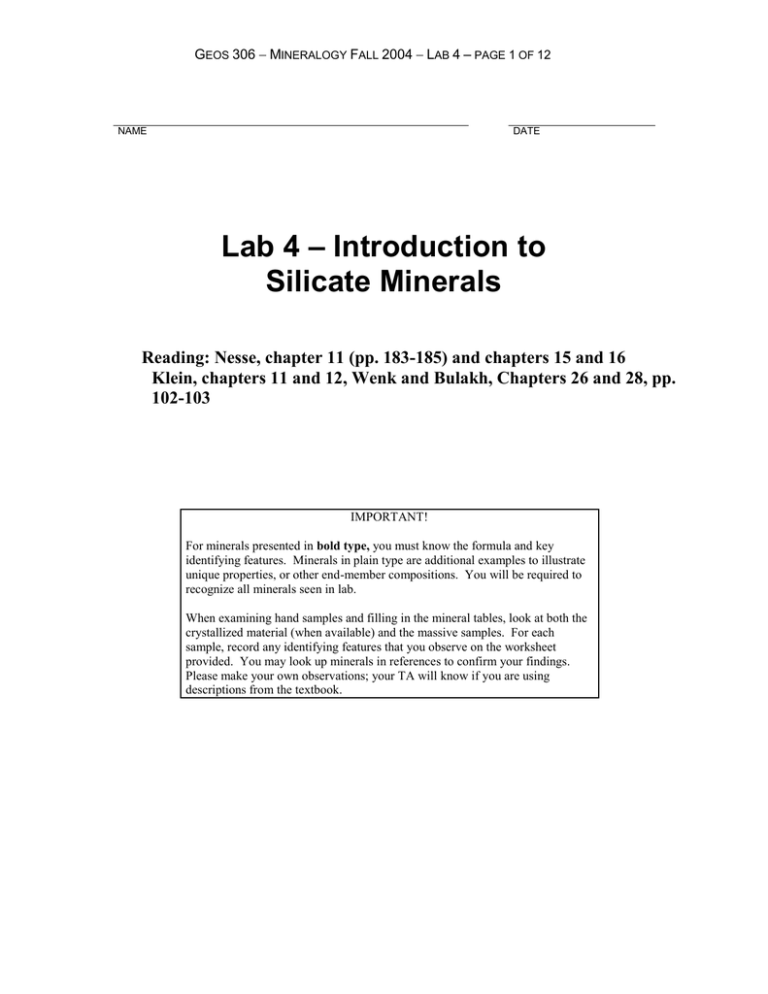
GEOS 306 MINERALOGY FALL 2004 LAB 4 – PAGE 1 OF 12 NAME DATE Lab 4 – Introduction to Silicate Minerals Reading: Nesse, chapter 11 (pp. 183-185) and chapters 15 and 16 Klein, chapters 11 and 12, Wenk and Bulakh, Chapters 26 and 28, pp. 102-103 IMPORTANT! For minerals presented in bold type, you must know the formula and key identifying features. Minerals in plain type are additional examples to illustrate unique properties, or other end-member compositions. You will be required to recognize all minerals seen in lab. When examining hand samples and filling in the mineral tables, look at both the crystallized material (when available) and the massive samples. For each sample, record any identifying features that you observe on the worksheet provided. You may look up minerals in references to confirm your findings. Please make your own observations; your TA will know if you are using descriptions from the textbook. GEOS 306 MINERALOGY FALL 2004 LAB 4 – PAGE 2 OF 12 Silicate Minerals Silicate minerals are the most abundant minerals on earth’s surface. They include rock-forming minerals such as quartz, feldspar, pyroxene, and amphibole. The basic building block of silicates is the silicate tetrahedron, SiO44-. In the Pauling sense, silicon has completely filled its outer valence shell, while each oxygen still requires an additional electron. The oxygen anions in the tetrahedron may obtain electrons from other cations, or from other silicate tetrahedra. Sometimes, Al substitutes for Si inside a tetrahedron, forming aluminosilicates. In this case the oxygen anions require even more cations to fill their valence shells. Silicon is the metallic element Si, silica is the compound SiO2, and a silicate is a compound containing SiO44-. tetrahedra, while silicone is a polymer containing Si and H. Classification of the silicates is based on the polymerization of the silicate tetrahedron. As you might guess, a silicate tetrahedron may share corners with up to four other tetrahedra. The following figure from Nesse illustrates the characteristic combinations of SiO4 tetrahedra: a. b. c. d. e. f. f. Nesosilicates, orthosilicates, or isosilicates have isolated tetrahedral silicate SiO4-4 groups. (e.g. garnet, olivine). Sorosilicates or disilicates have two corner linked SiO4-4 tetrahedra, giving rise to (Si2O7)-6 groups. (e.g., epidote). Cyclosilicates or ring silicates form when SiO4-4 groups link to form 3, 4, or 6-membered rings. The sixmember ring has the composition Si6O18–12 (e.g. beryl, tourmalines). Single chain silicates occur when the silicate tetrahedra form infinite chains with the bulk composition of Si2O6–4 (e.g., pyroxenes). Double chain silicates have the composition Si4O11–6, also written Si8O22–12 (e.g., amphiboles). Phyllosilicates or sheet silicates contain sheets of silicate SiO4-4 tetrahedra. Three of the oxygen atoms of the SiO4-4 tetrahedron adjoin neighboring tetrahedra, forming infinitely extending flat sheets. The empirical formula of this structure is Si2O5–2 (or Si4O10–4). (e.g., mica) Tectosilicates or framework silicates consist of frameworks of silicate tetrahedra. Each of the four oxygen atoms of the SiO4-4 tetrahedron is shared with adjoining tetrahedra. (e.g. orthoclase, nepheline, plagioclase). The joining tetrahedra could be silicate, or even AlO4, BeO4, and BO4. In the example of quartz, a three-dimensional network of silicate tetrahedra results in the overall composition of SiO 2 with a net charge of zero. GEOS 306 MINERALOGY FALL 2004 LAB 4 – PAGE 3 OF 12 Isomorphism and solid solution Two or more minerals are isomorphous when they share a crystal structure but have different chemical compositions. An example of an isomorphism is olivine, which consists of the two minerals fayalite (Fe2SiO4) and forsterite (Mg2SiO4). Both forsterite (fo) and fayalite (fa) have the same crystal structure, and consequently the same crystal system, orthorhombic. Fo and Fa are end members of a complete solid solution series meaning that substitution of one element by another occurs over the total possible compositional range, as defined by the two end member compositions. At San Carlos, the olivine ranges from Fo90 to Fo75. Members of this solid solution series are known as olivine, and since Fo dominates more often than Fa, olivine’s composition is written (Mg,Fe)2SiO4. Usually if the difference in radius between the atoms that substitute for each is not bigger than about 15% we can have complete solid solution. If the substitution doesn’t occur over the entire compositional range we have partial substitution. Note: When writing a composition with many elements in parentheses, the first element in the list must be dominant in that position in the crystal structure. Coupled substitution occurs when two pairs of substitutions happen simultaneously. For instance if in a general composition of A2+X2- a cation B3+ substitutes for some of A2+, electrical neutrality can be maintained if an identical amount of A2+ is at the same time replaced by a cation C+. This coupled substitution can be represented by 2A2+ = 1B3+ + 1C+ with identical total electrical charges on both sides of the equation. The plagioclase feldspar series consists of two end members, NaAlSi3O8 (albite) and CaAl2Si2O8 (anorthite). The complete solid solution between these two end member compositions illustrates coupled substitution: Na1+Si4+ = Ca2+Al3+. This means that for each Ca2+ that replaces Na+ in the plagioclase structure, one Si4+ must also be replaced by Al3+ in the framework. The equation shows that the total electrical charges on both sides of the equation are identical; as such the structure remains neutral. In the example of framework silicates, coupled substitution takes Si4O8 and substitutes both NaAl for one of the silicon atoms to give NaAlSi3O8. GEOS 306 MINERALOGY FALL 2004 LAB 4 – PAGE 4 OF 12 Exercise 1. (1 pt) CaMgSi2O6 and NaAlSi2O6 form a partial solid solution. What elements are substituting for each other? (1 pt) Is this an example of simple or coupled substitution? Exercise 2. Fun with valences (10 pts)Determine the valence of the R cation and the silicate structural family for each of the following. compound Mg3 R2Si3O12 RMgSi2O6 (Na,R)(AlSi3)O8 (Sc,R)2Si2O7 R3(Si4O10)(OH)2 charge or quantity of missing cation silicate family GEOS 306 MINERALOGY FALL 2004 LAB 4 – PAGE 5 OF 12 Exercise 3. Orthosilicates I - olivine Examine the samples of forsterite. The green color of forsterite is due to ferrous iron content, and changes to brown and eventually black with increasing iron content. Forsterite is significantly more abundant than fayalite, the latter of which appears mostly in volcanics. (1 pt) What color is pure synthetic forsterite? (1 pt) Fill in your observations. Also look up the chemical formulae. Confirm your observations against your textbook or field guide. mineral (& formula) forsterite observations (3 pts) Draw a phase diagram of a complete solid solution series between forsterite and fayalite (mole fraction of forsterite vs. temperature at 1 atm). Suppose that olivine crystals grow from magma of an initial bulk composition of Fo50. Are the first-formed crystals enriched in Mg or Fe? GEOS 306 MINERALOGY FALL 2004 LAB 4 – PAGE 6 OF 12 Exercise 4. Orthosilicates II – Garnet Group Garnets, X3Y2(SiO4)3, are an important structure type of minerals. In the field, it is easy to identify garnet based on its equant habit with 12 or 24 faces. Pyrope, Mg3Al2(SiO4)3 is a significant phase in the upper mantle and the garnet majorite Mg3(Fe,Si,Al)2(SiO4)3 with both octahedral and tetrahedral silicon is a major component of the transition zone. (20 pts) Fill in the blanks. Based on chemistry, what color do you expect each mineral exhibits when it is pure? X Y Color (pure) Colors (observed) pyrope almandine spessartine grossular andradite (2 pts) Using XralDraw or your textbook, find out the coordination numbers of X and Y cations. Exercise 5. Orthosilicates III (4 pts) Examine samples of zircon, staurolite and the Al2SiO5 polymorphs. Write your observations and the chemical formulae for these minerals in the table below. mineral (& formula) zircon staurolite topaz titanite (sphene) observations GEOS 306 MINERALOGY FALL 2004 LAB 4 – PAGE 7 OF 12 Exercise 6. Orthosilicate VI - Aluminum silicates (3 pts) These three minerals are all polymorphs; they all have the same composition. They serve as indicators of pressure and temperature in metamorphic systems. Their appearances are quite distinct; sillimanite in this lab forms white to cream fibers admixed with sugary granular quartz. kyanite andalusite sillimanite (4 pts) Draw a P-T diagram for kyanite-andalusite-sillimanite stability field. At what T and P, can these 3 phases coexist? GEOS 306 MINERALOGY FALL 2004 LAB 4 – PAGE 8 OF 12 Exercise 7. Disilicates (3 pts) Examine the minerals below. Epidote indicates a ferric iron content in a rock; it is commonly found in skarns. Vesuvianite is also found in skarns. Hemimorphite is distinguished by its habit and occurrence with limonite. mineral (& formula) epidote properties vesuvianite hemimorphite Exercise 8. Ring Silicates (3 pts) Examine the samples of beryl, cordierite and tourmaline. Using an overhead projector, try to see the pleochroism in cordierite. Write your observations and the chemical formulae for these minerals in the table below. mineral (& formula) beryl cordierite tourmaline properties GEOS 306 MINERALOGY FALL 2004 LAB 4 – PAGE 9 OF 12 Exercise 9. Single Chain Silicates - Pyroxene compositions (24 pts)Pyroxenes are single chain silicates of the general formula XYSi2O6. Fill in the table below. Compare the formulas of the pyroxene minerals. X Y valence of X valence of Y enstatite diopside hedenbergite spodumene jadeite aegerine (1 pt) Do you think that enstatite and diopside form a complete solid solution? Justify your answer. (6 pts) Draw a diagram for pyroxene group with enstatite, diopside, hedenbergite, and ferrosilite at the corners. Insert and label the fields for clinopyroxene and orthopyroxene. GEOS 306 MINERALOGY FALL 2004 LAB 4 – PAGE 10 OF 12 Exercise 10. Single Chain Silicates - Pyroxenes (2 pts) Pyroxenes are a group of single chain silicate minerals with a prismatic cleavage angle of 87°. Examine the pyroxene samples and write your observations below. Hedenbergite is brown and fibrous; you may not observe the cleavage on its fibers. mineral diopsidehedenbergite observations spodumene (2 pts) Pyroxenoid group: mineral rhodonite wollastonite observations GEOS 306 MINERALOGY FALL 2004 LAB 4 – PAGE 11 OF 12 Exercise 11. Double Chain Silicates - Amphiboles (4 pts) Amphiboles are a group of double chain silicates, showing prismatic cleavage at an angle of about 124º. The cleavage angle difference between pyroxenes and amphiboles is the most obvious method for differentiating these mineral groups. Tremolite is a low iron amphibole, appearing in pale colors. With increasing substitution of Fe2+ for Mg, a green color is imparted and the mineral is then called actinolite. Upon further increase of Fe content, and addition of Fe3+ into the structure, the mineral becomes quite dark, nearly black, and is called hornblende. Hornblende is a geologic term for a mafic amphibole; it does not correspond to a specific composition; its uneven texture is useful for identification. mineral (& formula) actinolite tremolite nephrite hornblende observations GEOS 306 MINERALOGY FALL 2004 LAB 4 – PAGE 12 OF 12 Exercise 12. Mineral Identification Eight minerals need your identification. All minerals are discussed above, but may look a little different. Use your observations from above to identify these minerals. identity 1 Blue crystal 2 Whitish big crystal 3 Dark crystal 4 5 how do you know?

